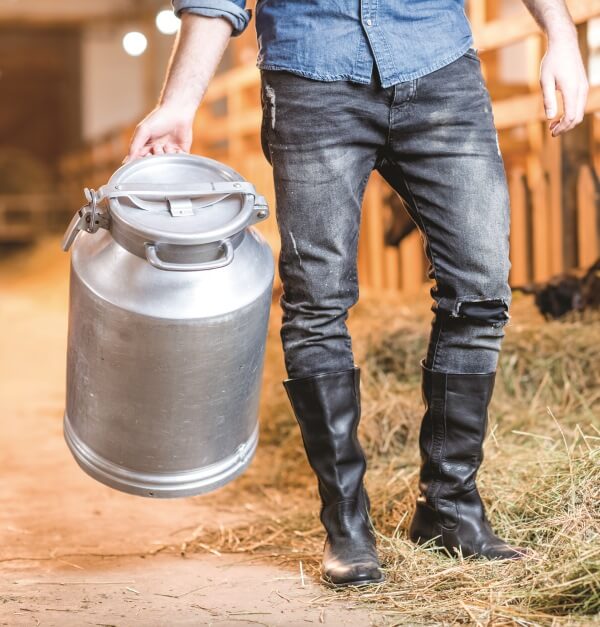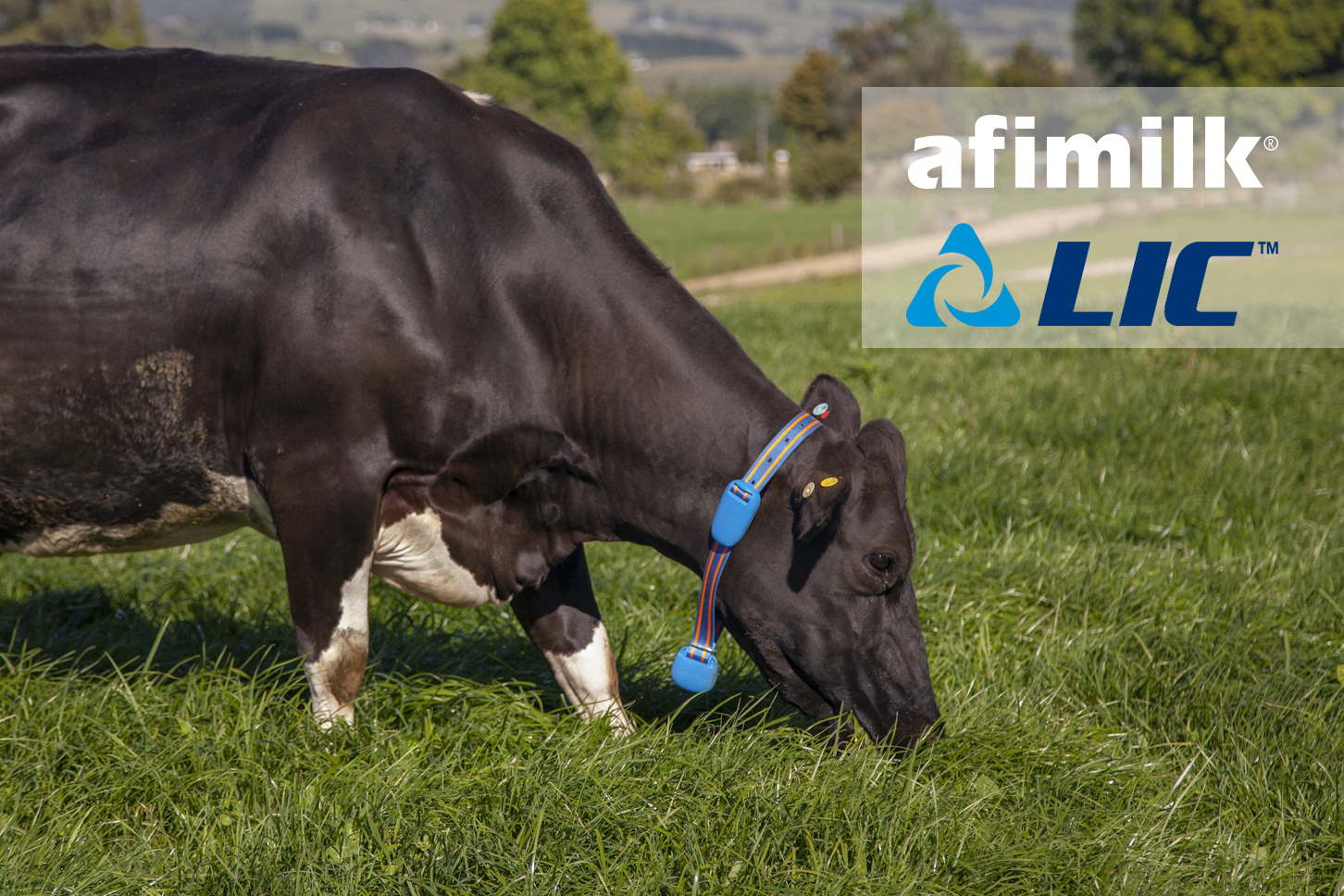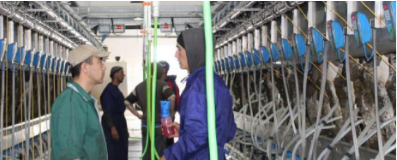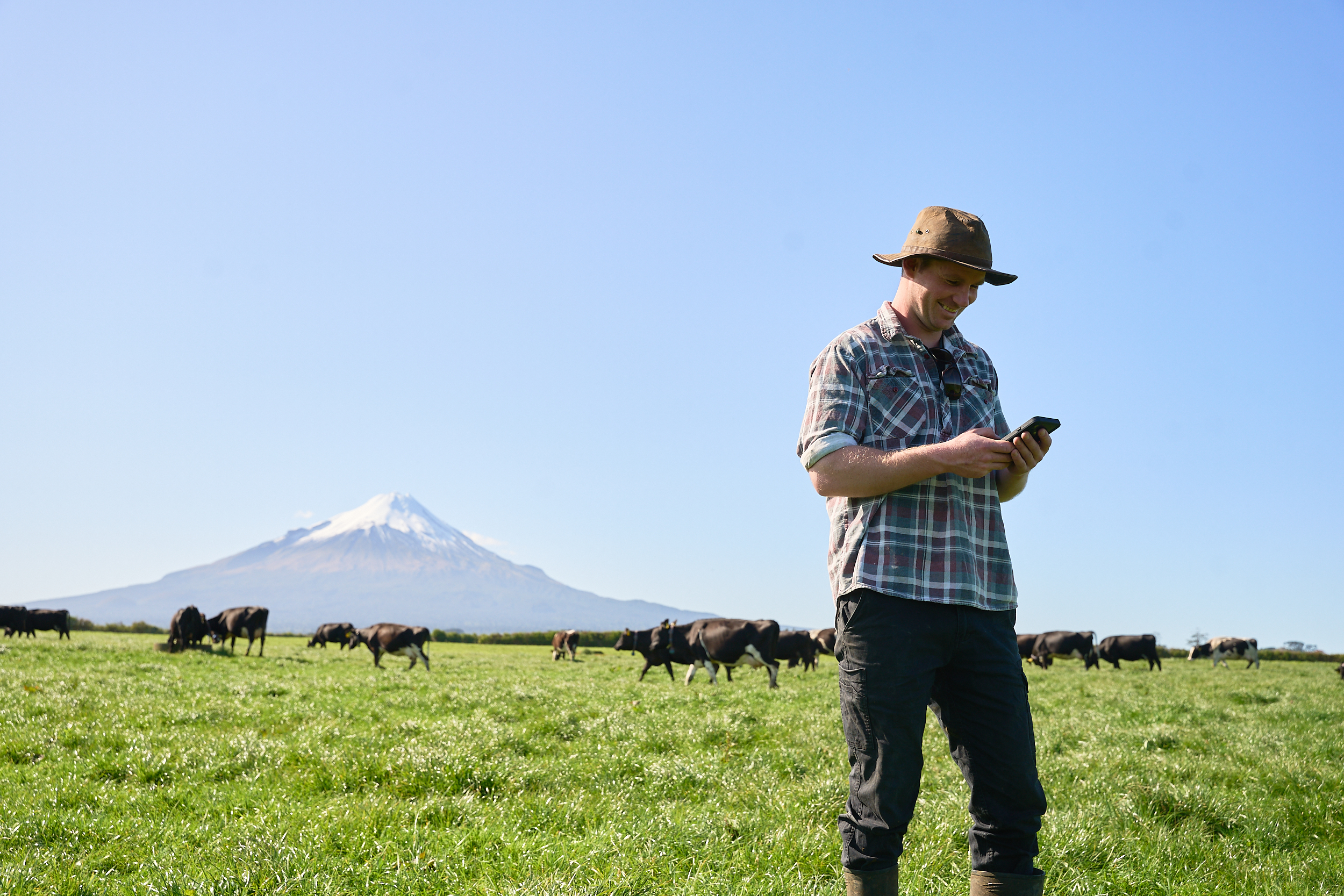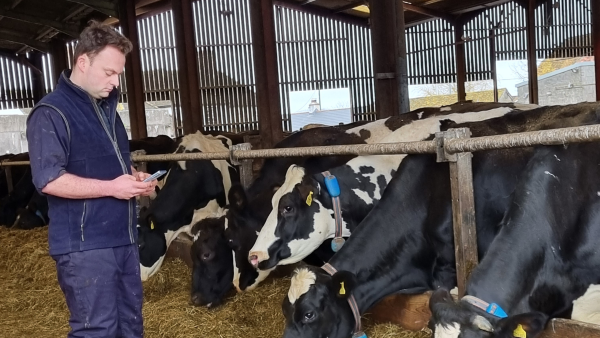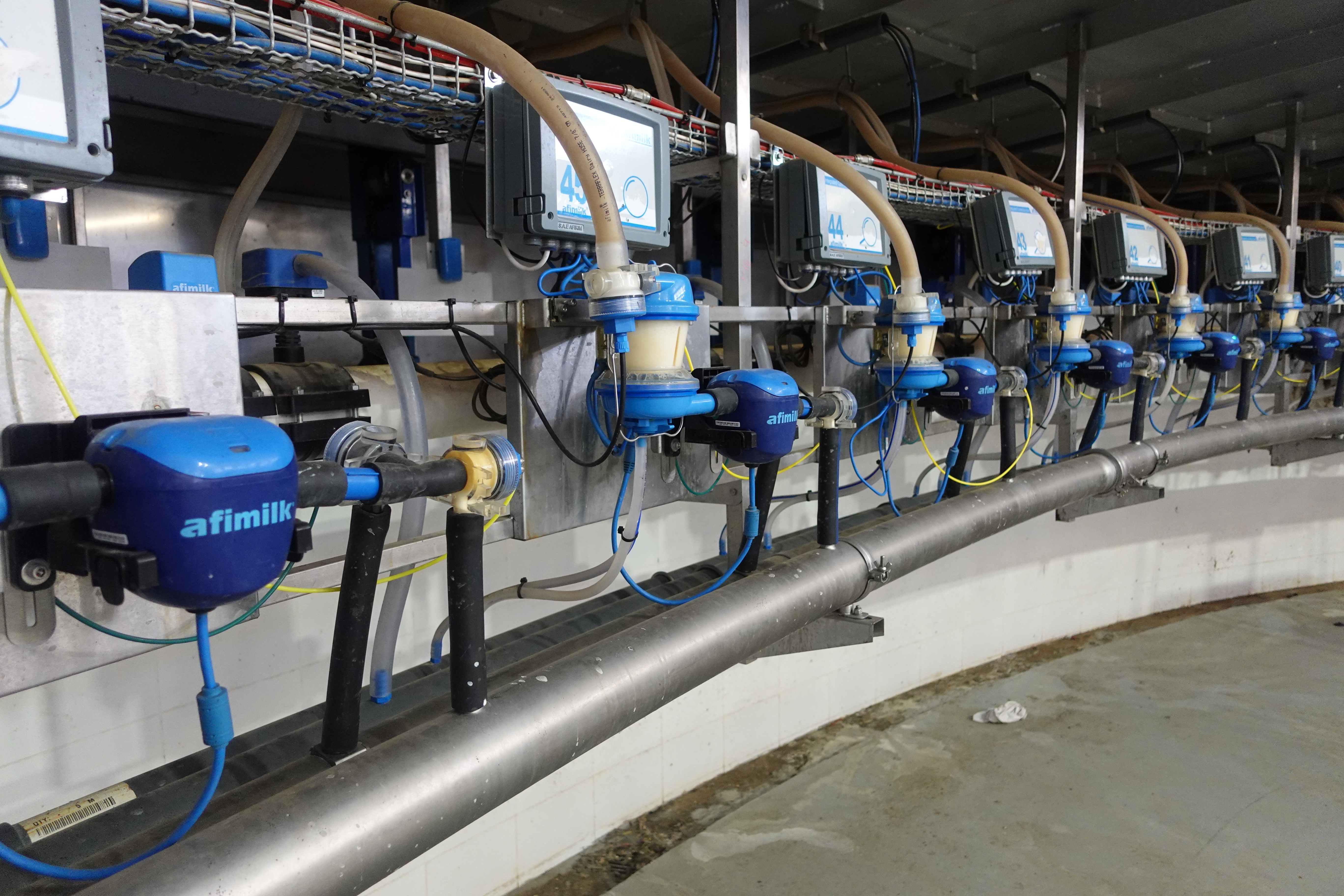Ginsberg R, National Service for Udder Health and Milk Quality – Israel Dairy Board
Abstract
The first aim of this study was to monitor parlour performance in high producing Israeli herds using the parameter proposed by Reid and Stewart (2007) for herds milked three times daily, 55 kg milk/stall/hour. Milk yield, somatic cell count and the culling rate were monitored correspondingly.
The second aim was to examine if by increasing manufacturers default take-off settings in Israel, there will be no detrimental effect on parlour performance and udder health (SCC). A survey was carried out in 2010 on 32 top producing herds totalling 9347 cows averaging 13,208 kg/cow/year and 173,000 SCC. 44% of the herds monitored achieved the 55 kg milk/stall/hour recommended by Reid and Stewart. In 2008 a random survey of 32 farms with an average milk yield of 11,885, similar to the herd book average, only 16% of the herds surveyed attained the above mentioned target. When checked against a proposal of 50 kg milk/stall/hour by Reid (2008), 59% of the herds in 2010 and 32% of the herds in 2008 reached the recommended target.
In the current survey two subgroups with different cluster take of settings were compared. Nineteen farms had takeoff settings of less than 600 gr/min, whereas 13 farms had settings above 600 gr/min, the latter were significantly higher than manufacturers default settings (350 – 480 gr/min). Only 7 of the 19 farms (37%) attained the proposed parlour performance whereas 7 of the 13 farms (54%) attained this goal. There was no significant difference in milk yield, SCC and culling rate between the two subgroups.
Although Average SCC in the herds surveyed was lower than the national average, there was no evidence of negative effects on udder health (SCC) by increasing takeoff settings to a level of 600 gr/min or above.
Key Words: high yielding cows, computerized management systems, commercial dairy farms
Introduction
Lactation in the dairy cow is influenced by various management factors as well as the milking equipment. Milking efficiency is a combination of proficiency of the milker, operation of the milking equipment, and cow factors including udder shape, temperament and physiological traits.
Computer monitoring is common in Israeli dairy herds, helping in the assessment of parlor performance on individual farms, to advise on possible shortcomings, and to monitor recommendations and improvements (Ginsberg et al. 2010 and Ginsberg et al. 2011).
Parlour throughput can be measured in various ways: cows/hour, milk/hour, milk/stall, milk/shift or milk/stall/hour to name a few. The latter is the best way to measure overall parlour performance thereby neutralizing the size of the milking parlour and number of milkers (Reid and Stewart 2007). Their proposed goal for herds milked three times daily in parlours was 55 Kg/stall/hour.
In 2008 Ginsberg et al. (2010) conducted a random survey on 32 farms to monitor parlour performance using a different proposal by Reid (2008) of 50 kg milk/stall/hour. Results of this survey showed that 32% of herds milked three times a day, yielded the recommended goal. In order to achieve optimum parlour performance all parameters of the milking equipment must be fine-tuned including the automatic cluster removers (ACR).
The use of automatic cluster removers has led to a significant reduction in over-milking, and a reduction in machine on time (Rasmussen 1999). The delay for cluster removal is embedded in the milk meter. Long removal delays result in a longer time under a low milk flow rate at the end of the milking. Although milk meter settings are determined by agreement between the herdsman and the equipment installer, most manufacturers allow the milker to manually override the automatic take-off settings. In many parlours, the most conscientious workers will disable the automatic take-offs (set take-offs to manual), because of the desire to be absolutely certain that every cow is completely milked out.
Historically, cows were considered milked out when the milk flow rate decreased to 200 gr/min and most ACR’s were set to this level. Early studies by Sagi (1978) and Rasmussen (1993) concluded that the cluster can be detached at a flow rate of 400 gr/min. Milking time was significantly shorter, with no negative effect on the milk yield and the incidence or prevalence of clinical and sub clinical mastitis.
Stewart & Reid (1997) studied the effects of parlour performance on two farms by changing detacher settings. The results showed a reduction in unit on time. The managers also reported that cows were calmer in the milking parlour.
Further studies with different management strategies and goals supported the results of all of the previous studies. (Stewart et al. 1999, Stewart and Godden et al. 2002, Maggliaro and Kensinger 2005, Billon et al. 2007).
Jago et al. (2010) once again studied the effect of raising the take-off settings from 200 to 400 gr/min on pasture-based cows in New Zealand, milked twice daily with a minimal pre-milking routine. The results concurred with all previous studies.
By monitoring the milk yield of the highest producing herds in the Israeli Herd book, Kg/cow/year, the aim of this study was to; a( Compare the average SCC (as an indicator for udder health) of the herds surveyed to the national average and possibly demonstrate that manufacturers default take-off settings in Israel (350 – 480 gr/min) can be increased with no detrimental effect on udder health. b) Monitor the ATO settings and parlour performance in high producing Israeli herds. c) Compare the parlour performance (milk/stall/hour) in this survey to the results of a previous random survey. In the present study we examined to that extent the surveyed farms met the goals of 50 and 55 Kg/stall/hour respectively.
Materials and methods
Forty of the highest producing Israeli herds milked three times daily were screened in order to attain; a) manufacturer of the milking equipment, b) take-off settings, c) number of milking stalls and d) milk production at each milking on ten consecutive days. Farms using milking robots or weigh jars were not included in the survey leaving 32 farms to be monitored individually.
Information from the 2010 Israeli dairy herdbook showed that these 32 herds had average annual milk yields between 12,500 and 14,400 Kg and ranged in size from 45 to 937 cows. Data monitored from the herd included a) yearly milk production, b) annual SCC averages and c) culling rate.
Although there are many types of milk meters used in Israel, all of the farms in the study used only “Afimilk” (SAE Afikim, Kibbutz Afikim, Israel) and “SCR” (SCR Engineers Ltd, Netanya, Israel) milk meters. On farms using “Afimilk” equipment the parameter milk/stall/hour is part of the parlour performance report needing no further calculation. On farms using SCR equipment, the calculation was made based on milk yield and total milking time at each milking obtained from the herd management program, divided by the number of milking stalls. Results 25 of the farms surveyed (78%) used “Afimilk” milk meters with a default detachment setting of 480 gr/min, only 7 farms (22%) in the survey used SCR equipment with a default detachment setting of 350 gr/min. (Table 1)
Table 1: Distribution of Milk Meters by Manufacturer and Default Detachment Settings

In 2010 Parlour performance was determined in a survey of 32 top producing herds with 9347 cows averaging 13,208 kg milk/cow/year, the production difference was 1688 Kg higher than the herdbook average. In 2008 a random survey of 32 herds with 9088 cows using “Afimilk” equipment and producing 11,885 kg milk/cow/year with a difference of 424 Kg in milk production between the surveyed herds and the average milk production of all Israeli herds in the fore mentioned year. Culling rate on farms surveyed in 2010 was slightly lower than the national average and lower than the previous survey, testifying to less stringent culling criteria. (Table 2)
Table 2: Comparison of survey data to total herd book data

Although there was no difference in annual somatic cell counts on farms surveyed in 2008, the average annual somatic cell counts on farms surveyed in 2010, was 173,000/ml; 58,000 lower than the national average of 231,000/ml. This data was insignificant due to the large distribution and the fact that 12.5% of herds surveyed were above the national average.
Results of individual herds surveyed showing detachment settings (gram/min.) and parlor performance (milk/stall/hour) are presented in figure 1
Fig. 1 Comparison of parlor performance by herds – milk/stall/hour and detachment settings
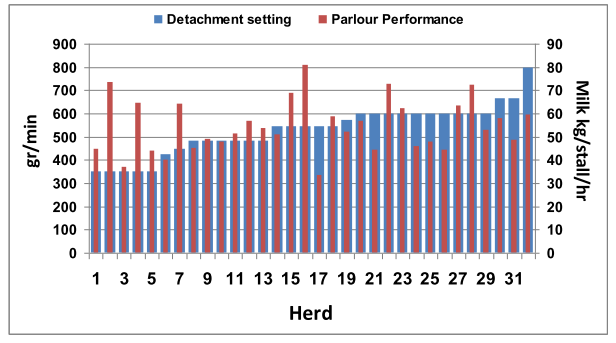
In the random survey of 2008 only 5 of the farms (16%) met Reid and Stewart’s (2007) proposed target (55 kg milk/stall/hour). In the survey of high producing herds in 2010, this target was reached by 14 of the farms (44%), a significant improvement when compared to the previous survey. When checked against the proposal of Reid (2008) of 50 kg milk/stall/hour, 59% of the herds in 2010 and 32% of the herds in 2008 reached the recommended target.
Detachment settings were not monitored in 2008 but this was after the introduction of a new management program where default detachment setting were raised from 343 gr/min to 480 gr/min and very few if any farms had settings above this level.
In 2010, 19 of the farms surveyed using Afimilk equipment had take off settings above the factory default of 480 gr/min, only 6 farms did not change the default settings. All of the farms using SCR equipment were below 480 gr/min. 65% of the farms surveyed had take off settings higher than 480 gr/min the vast majority (13) with 600 gr/min and as high as 800 gr/min.
Two subgroups with different cluster take of settings were compared, 19 farms with takeoff settings of less than 600 gr/min and 13 farms with settings of 600 gr/min and above.
Only 7 of the 19 farms (37%) with default settings less than 600 gr/min attained the proposed parlour performance whereas 7 of the 13 farms (54%) with settings above 600 gr/min attained the goal of 55 kg milk/stall/hour. When compared against 50 kg milk/stall/hour, 11 of the 19 farms (58%) with default settings of less than 600 gr/min attained the recommended parlour performance, 8 of the 13 farms (62%) with settings above 600 gr/min attained this goal.
There was no significant difference in SCC and culling rate between the two subgroups (Table 3).
Table 3: Influence of different detachment settings on parlor performance, SCC and culling rate.

Discussion
Parlour performance depends on various factors: milk yield, frequency of milking, number of milkers and their skill, cow movement, cow grouping strategy, milking routine; unit attachment time, how fast peak flow rate is achieved, unit detachment settings and more. The use of computerized dairy management systems have contributed greatly in the evaluation of parlour performance.
Reid and Stewart’s (2007) parameter of 55 kg milk/stall/hour and Reid’s (2008) proposal of 50 kg milk/stall/hour for parlour performance in herds milked three times daily are one of the tools in evaluating parlour performance. This parameter expresses the combined influence of milkers, cows and milking equipment. Using a computerized dairy management system it is possible to calculate and display this parameter.
In this study on Israeli top producing herds, 44% of the herds monitored yielded the recommended 55 kg milk/stall/hour, whereas in a random survey in 2008 on herds with a milk yield similar to the herd book average, only 16% of the herds attained the above mentioned target.
When checked against a proposal of 50 kg milk/stall/hour by Reid (2008), 59% of the herds in 2010 and 32% of the herds in 2008 reached the proposed target. The large discrepancy in parlour performance when reducing the goal by 5 kg milk/stall/hour, suggests that a larger number of farms needs to be surveyed in order to determine a goal for optimal parlour performance.
Although it is a known fact that the milk curve and flow rate influence parlour performance (Reneau and Chastain 1995, Reid and Stewart 2007, Reid 2008), there was no way to monitor these parameters in 22% of the farms using SCR equipment, therefore this parameter that possibly influenced the performance of some of the herds surveyed was not checked in this study. We must therefore hypothesize that the improvement in the number of herds reaching the recommended goal is due to the fact that in this study cows yielded 1688 Kg/milk higher than the average in the herdbook.
The second aim of the study was to examine if by increasing the manufacturers default take-off settings, there will be any detrimental effect on parlour performance and average SCC as an indicator for udder health. In the current survey two subgroups with different cluster take of settings were compared, 19 farms with takeoff settings lower than 600 gr/min against 13 farms with settings above 600 gr/min, the latter were significantly higher than manufacturers default settings (350 – 480 gr/min).
Fewer farms (37%) with detachment settings below 600 gr/min attained the parlour performance goal of 55 kg milk/stall/hour than then farms obtaining the goal of 50 kg milk/stall/hour (54%). Farms with settings above 600 gr/min were not affected. The correlation between take of setting levels and the parlour performance goals is obvious. As there was no significant difference in milk yield, SCC and culling rate between the two subgroups, this finding suggests that take of settings can be raised with no detrimental effect on udder health (SCC), as well as having no effect on herd health and fertility (culling rate).
Average SCC in all of the herds surveyed, although 58,000 cell/ml lower than the national average, were not statistically significant. Nevertheless, there was no evidence of negative effects on udder health. Further study has to be done in order to explore possible positive effects on udder health.
The findings of this study support the results of previous studies indicating that default ACR settings can be set at 600 gr/min with no detrimental effects on milk yield, udder health and milk quality.
Computerized dairy management systems are helpful in monitoring different management related factors on a large number of cows in commercial dairy farms and to advise the farmer how to improve parlour performance.
References
Billon, P., Pledel D.. and Gaudin V. Effects of increasing the milk flow switch point when using ACR’s on milking and milk quality. Proc. Annual Meeting of the National Mastitis Council pp 222-223 2007
Ginsberg R., Livshin N., Rak D., Sullivan Y., Arazi A., Aizinbud E.. Electronic computerized monitoring of milking efficiency and milking parlour turnover Proc. 5th IDF Mastitis Conference 464 – 467. 2010
Ginsberg R., Rak D., Arazi A., Aizinbud E. Detection and Prevention of Milking Routine Problems by Computerized Monitoring of Milking Irregularities. Proc. Annual Meeting of the National Mastitis Council. 167-168. 2011
Jago, JG, Burke, JL and Williamson, JH. 2010. Effect of automatic cluster removal settings on production, udder health, and milking duration. Journal of Dairy Science 93(6): 2541-2549.
Magliaro, A.L.and Kensinger, R.S. 2005. Automatic cluster removal settings effects milk yield and machine-on time in dairy cows. Journal of Dairy Science 88(1): 148-153.
Rasmussen, M.D. Influence of switch level of automatic cluster removers on milking performance and udder health. Journal of Dairy Research 60(3):287-297. 1993.
Rasmussen, M.D. Benefits from early removal of the milking unit Proc. British Mastitis
Conference 55-61.1999
Rasmussen, M.D. Overmilking and teat condition Proc. Annual Meeting of the National
Mastitis Council 169-175. 2004
Reid DA. Determining parlor performance. International Dairy Topics Vol.7, Number 3, pp 7-9, 2008.
Reid, D.A. Why unit on time is important for your dairy – Proc. Western Dairy Management
Conference 13-15. 2001
Reid, D.A. and Stewart, S.C. The effects on parlor performance by variation in detacher settings Proc. Annual Meeting of the National Mastitis Council 101-104 1997
Reid, D.A. and Stewart, S.C. Using electronic data to monitor and improve parlor performance Proc. Annual Meeting of the National Mastitis Council 12-17 2007.
Reneau JK, Chastain JP. Effect of cow prep on milk flow, quality and parlor throughput
Sagi R. Milk flow rate and end of milking detectors. Proc. Annual Meeting of the National
Mastitis Council 328-334 1978
Stewart, S.C., Eicker, S.W., Reid, D.A., and Mein, G. Using computerized data to find time for milk quality. Proc. Annual Meeting of the National Mastitis Council 116-122 1999
Stewart, S.C., Eicker, S.W., and Rapnicki, P. Automated collection of parlor performance data: Information needed and proposed standardized definitions. Proceedings of the 2nd
International Symposium on Mastitis and Milk Quality National Mastitis Council and
American Association of Bovine Practitioners 377-381 2001
Stewart, S.C., Godden, S., Rapnicki, P., Reid, D.A., Johnson, A., and Eicker, S.W. Effects of automatic cluster remover settings on average milking duration, milk flow, and milk yield.
Journal of Dairy Science 85(4):818-823. 2002
